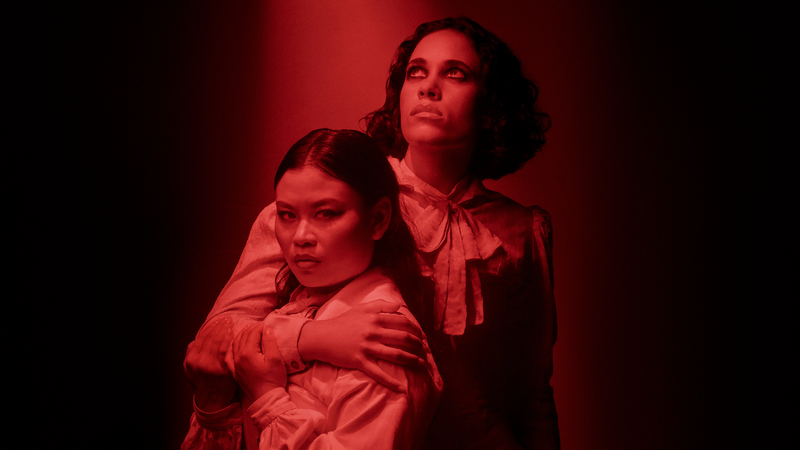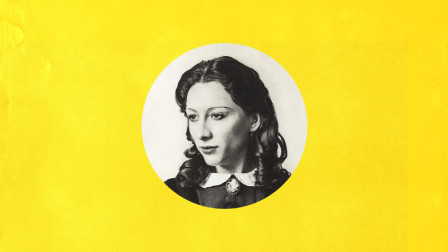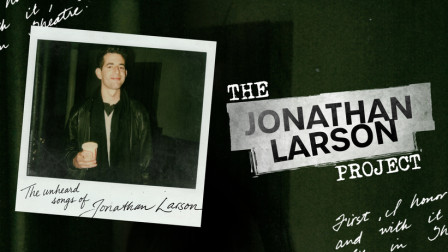Review: DRACULA at the Lyric Hammersmith
Dracula is one of the most iconic figures in horror fiction, and Bram Stoker’s gothic horror novel is the seminal archetype for vampire lore. So what happens when you have an adaptation of Dracula where the Count himself takes a backseat?
 Umi Myers and Mei Mac as Mina and Lucy in DRACULA at the Lyric Hammersmith. Photo by Marc Brenner.
Umi Myers and Mei Mac as Mina and Lucy in DRACULA at the Lyric Hammersmith. Photo by Marc Brenner.
Morgan Lloyd Malcolm’s adaptation of Dracula opens with a sharp bang in the darkness, eliciting screams from the unsuspecting audience, before Mina Murray-Harker steps onstage to deliver a monologue about the nature of fear. ‘Beware the teller as much as the tale,’ she warns us, setting the tone for a play that’s unexpected, unsettling, eerie, and downright clever.
In Stoker’s novel, the narrator is Jonathan Harker, who tells the story of his trip to Dracula’s castle in Transylvania, where he’s imprisoned until the Count makes his journey to England to torment the beautiful Lucy Westenra. In this version, it is Mina who not only narrates but controls the narrative, interjecting to critique, direct, and question the other actors, and also hitting pause (literally, on an old-fashioned stereo) on the performance to address the audience.
It becomes chillingly clear that the characters are aware that they are actors recreating this story for us, with the frantic urgency of delivering a warning, and that something is terrifyingly different about tonight’s performance, as if an unknown presence is haunting it. This meta device of a play-within-a-play creates a delightfully sinister and immersive atmosphere, and builds up to a frightening twist at the end as the reason for the performance becomes clear.
Fear is a recurring theme of both the novel and this adaptation - fear of the unknown, of the Other, of sexual desire - and director Emma Baggott does a stunning job of evoking fear in every step of the performance. Grace Smart’s evocative, atmospheric set design features a backdrop of Gothic architecture lit by hellish red lighting. The vampires are otherworldly and monstrous, with Dracula’s Brides appearing as scuttling bird-like beasts draped in black cloth. Eerie sound design, well-timed jumpscares, and an overpowering sense of mounting dread serve to keep the audience on edge throughout.
Taking the spotlight are the two women, who in the novel represent the two sides of Victorian womanhood, with Mina being the virginal ideal and the more sexualised Lucy becoming a fallen woman. Here, they are fully realised, complex characters, and their love for each other, strongly implied to be more than platonic, drives the story. It also leads to the most poignant and haunting moments in the play: where Lucy, assaulted by Dracula, sobs and begs for forgiveness in Mina’s arms, or where a tearful Mina delivers a scathing monologue about all the things the world didn’t see about Lucy. The scene where the three suitors stake the vampire Lucy is drawn-out and brutal, reading more like a gang rape than the slaying of a monster.
Umi Myers’ Mina is unapologetically fierce, defiant, and full of sardonic quips and asides as she monitors the events of the play from the sidelines. Mei Mac as Lucy switches seamlessly between wide-eyed girlishness and moments of heartbreaking self-awareness before transforming into a vampire that is more predator than seductress. Jack Myers’ Jonathan is hapless and nervous, an actor resistant to his part and his director, shifting between comical foppishness and an almost menacing attempt to assert male dominance. The other men of the play, played by the ensemble cast (all female or non-binary), are more caricatures than characters, particularly Lucy’s three bumbling suitors, whom Mina views with unabashed scorn (and jealousy?). The cartoonish binary of gender roles feel a bit on the nose, but inspire much of the play's comedy.
As for Dracula himself? The titular character is conspicuously notable for his lack of presence. He appears only as a shadow, his lines delivered through a recorded voiceover. In places this felt a bit frustrating for the audience and the voiceovers came across as slightly cheesy during tense scenes. In other places, it adds to the sense of horror, particularly the scene where he picks off the sailors on the Demeter one by one as the ship fills with fog. His invisibility allows our imagination, and individual fears, to fill in the blanks with something more horrific than the play could ever create.
But it’s clear this retelling is deliberately about Mina and Lucy, and the sidelined Dracula is just a vehicle to explore feminine rage. This theme is delivered with occasional heavy-handedness, especially when Mina breaks the fourth wall and addresses the women in the audience. But one can excuse this, given that the exploitation of women’s bodily autonomy, explored here through vampirism, feels soberingly relevant in this day and age.
Overall, Dracula is a unique and haunting reimagining, one which allows us to relive the familiar story from new and unexpected angles, investigating matters of storytelling, fear, and womanhood through that wonderfully versatile and malleable genre: horror.
Dracula is playing at the Lyric Hammersmith until October 11th 2025.
Latest News

 Review Round-Up: OH, MARY! at the Trafalgar Theatre
19 December 2025 at 15:53
Review Round-Up: OH, MARY! at the Trafalgar Theatre
19 December 2025 at 15:53

 The Jonathan Larson Project announces London premiere
19 December 2025 at 10:31
The Jonathan Larson Project announces London premiere
19 December 2025 at 10:31

 Oh, Mary at Trafalgar Theatre Review
19 December 2025 at 09:46
Oh, Mary at Trafalgar Theatre Review
19 December 2025 at 09:46

 Kerry Ellis completes cast for West End concert of Jo - The Little Women Musical
19 December 2025 at 09:35
Kerry Ellis completes cast for West End concert of Jo - The Little Women Musical
19 December 2025 at 09:35